Best MTB groupsets: the best mountain bike groupsets tested
Smooth shifting with BikePerfect’s round-up of the best MTB groupsets to buy this year
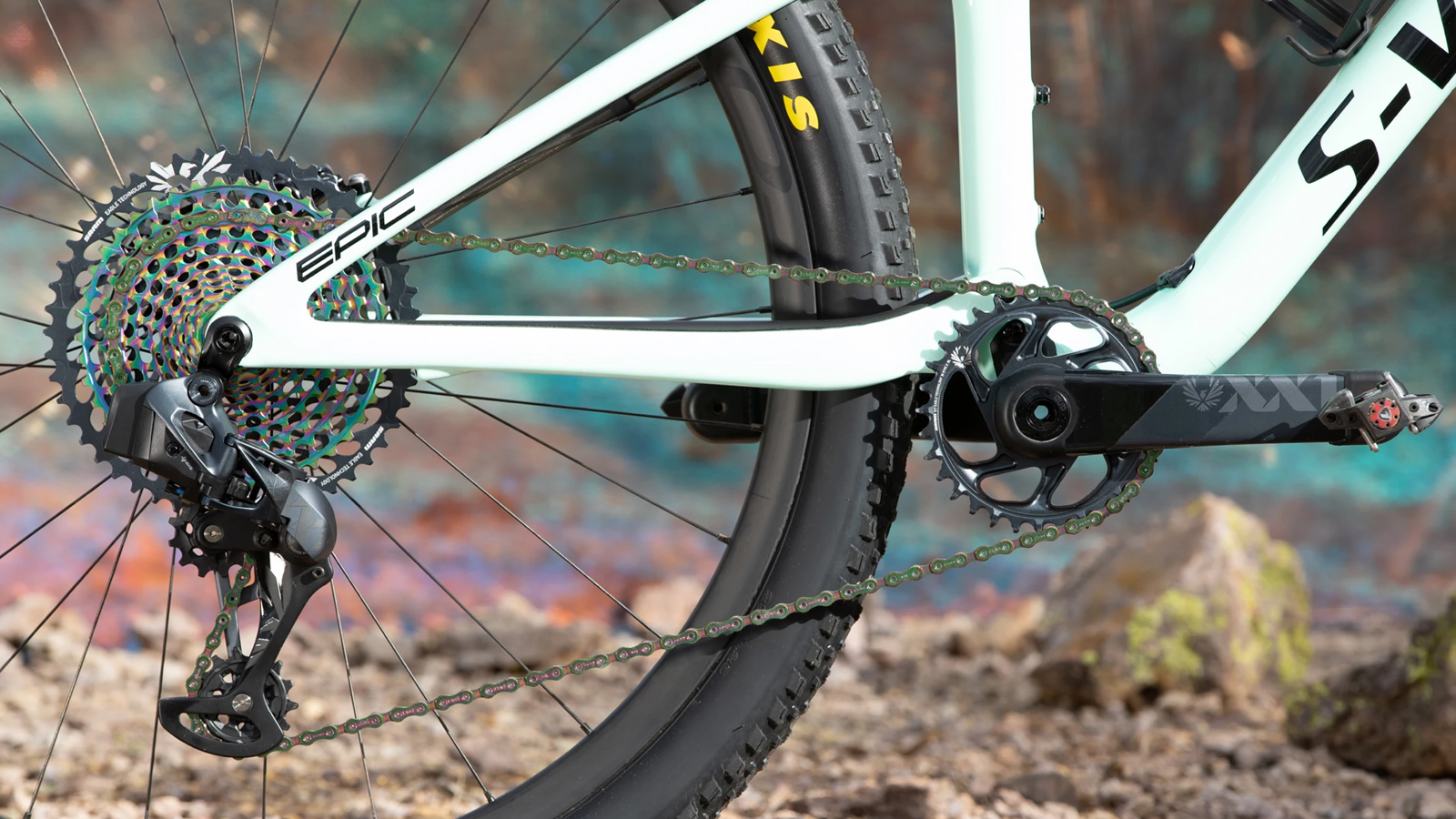
SRAM Eagle AXS might be the smartest and slickest groupset ever produced but does Shimano’s new SLX set a new standard for affordable performance?
Whether you’re choosing what level of bike to buy, building up a frame or replacing kit you’ve killed, you need to know what the pros and cons are of each component group from the major manufacturers.
Best mountain bike cranks: the best MTB cranks for any budget
Best mountain bike brakes: Bike Perfect's best MTB brake picks
Best mountain bike forks: the best MTB forks for XC, trail, enduro and downhill
There's been some big developments too, with SRAM going AXS wireless on its top-end XX1 and X01 Eagle groups. Then Shimano dropped 12-speed versions of both XT and SLX literally weeks after long overdue XTR finally becoming available. Spanish crank maker Rotor has also jumped in with a mountain bike version of its radical hydraulically operated road gearset to really mix things up.
So where do you even start deciding what groupset will suit your riding best?
Every major MTB groupset ridden and reviewed
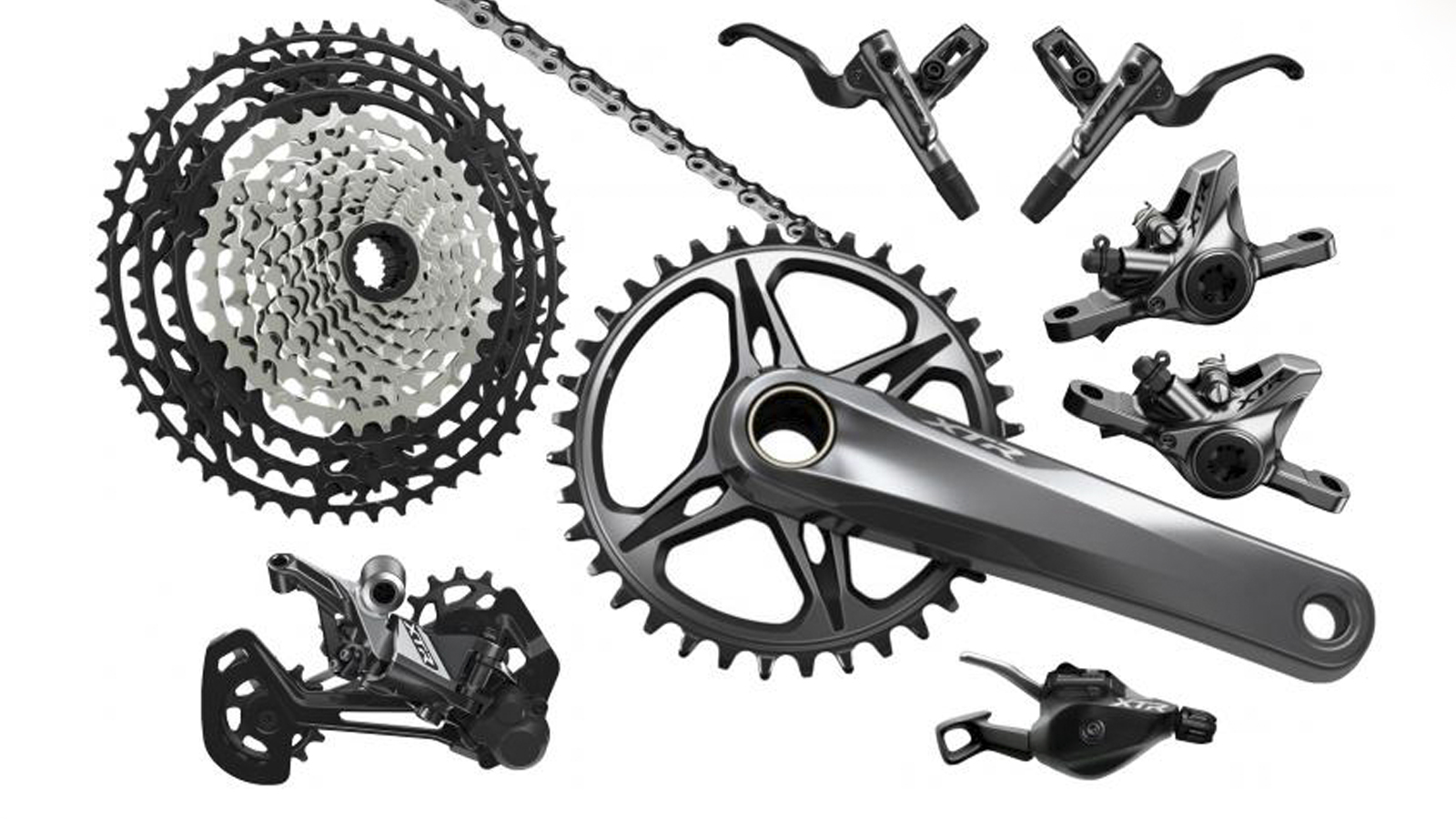
Shimano XTR
Specifications
Reasons to buy
Reasons to avoid
The first Shimano XTR groupset was held up with crank and hub issues and there’s still no sign of a Di2 option but the shifting performance is probably the sweetest wired set up around. After the last generation was too light for some riders, Shimano have introduced a clearly communicated click between gears. Shift effort has been reduced dramatically though and minimal free play makes gear changes instant. The front paddle gives a multi down shift advantage over SRAM, too.
They’ve totally reworked the tooth profiling on the Hyperglide+ cassette for the outstanding shifting under power. Higher quality materials and design detailing save 150g over XT (100g from the semi titanium cassette) and 20g lighter than cabled SRAM XX1. It’s priced almost the same as wireless SRAM and you’ll need a Microdrive freehub to upgrade.

Shimano XT
Specifications
Reasons to buy
Reasons to avoid
SLX has definitely stolen a lot of the thunder from Shimano’s original off-road groupset but XT still has enough XTR level detailing to make it a very worthwhile investment for its loyal fans. Sensitive riders might notice a fractionally stiffer action than XTR, but overall it’s the same light yet positive feel with the fantastic under power shifting of Hyperglide+. It also gets rubber trigger pads, multi downshift and a harder chain coating for tactile and lifespan wins. Two alloy teeth and a different cassette construction save 66g over SLX while other tweaks mean the overall gain is 97g and it’s 7g lighter and slightly cheaper than SRAM GX. Unlike SRAM it comes in 2x as well as 1x options but you’ll need a Microdrive freehub to upgrade from current Shimano.

Shimano SLX
Specifications
Reasons to buy
Reasons to avoid
Shimano SLX has always been the smart transmission choice from the Japanese component masters, but the latest version is the best yet by far. The obvious gain is the 12th sprocket which gives 10-51 or 10-45 tooth gear spread options. SLX also gets the latest Hyperglide+ tooth profiling and chain shaping that lets you change smoothly and surely, however hard you’re cranking. Together with a smaller final gear jump on the bigger cassette, Shimano has a noticeable edge over cabled SRAM when you’re coping with the steepest climbs. Unlike SRAM, it comes in 2x as well as 1x options but you’ll need a Microdrive freehub to upgrade from current Shimano.
SLX doesn’t get the multiple downshift function of XTR and XT but you do get finger and thumb triggers, and new, slimmer I-spec Evo brake and shifter junction architecture. A steel, rather than alloy, 45-tooth sprocket and simpler construction overall adds 66g to the cassette over XT, but SLX has a less durable chain treatment. There is the potential to cherry-pick a hybrid groupset together to get all the XT gains without all the cost.
If you’re not focused on weight and being able to smash two harder gears at a time though, SLX is definitely the most cost-effective workhorse transmission from Shimano’s new 12-speed lineup. It also feels less agricultural than SRAM’s more expensive NX, too.
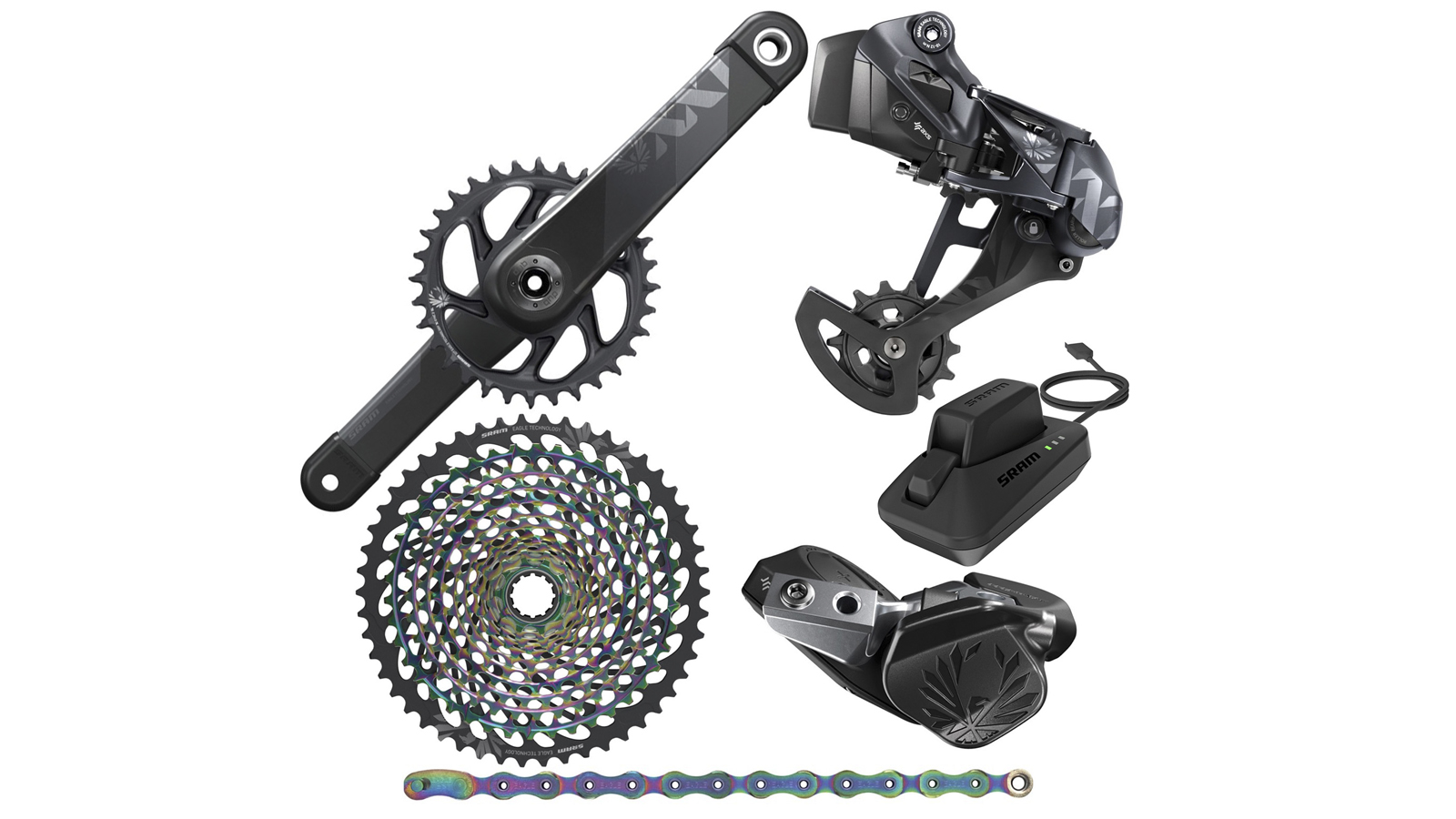
Specifications
Reasons to buy
Reasons to avoid
Gamechanger. A massively overused phrase, but SRAM really have pressed Ctrl Alt Delete on the premium gear landscape with their new AXS technology. Based around proven Eagle 12 speed architecture for smoothly positive wide-range shifting, AXS adds fully wireless actuation. Rather than mimicking analogue trigger feel like Shimano Di2, AXS uses a super neat rocker switch with an extra front knuckle button. Shifting is fully app programmable to operate in whichever direction or with however many sequential changes you want. It syncs with RockShox Reverb AXS dropper seatpost and AXS road/gravel systems too.
Presuming set up is accurate (SRAM provide a gauge) actual changes are pin-sharp and immediate, to the point where riders who normally hover their thumb over the shifter will have to learn to keep it clear to avoid accidental shifts. Despite the batteries and mech motor weight is still competitive and cost is almost identical to cabled XTR. If you’re not counting every gram or tend to hit the ground more, XO1 AXS uses an alloy jockey wheel backplate and other tweaks to create a slightly heavier, but tougher and cheaper wireless option.
Either way, the usual SRAM cage-lock tech makes wheel removal easy and a cunning reset switch protects the motor from trailside knocks. It’s also a mechanics dream to fit and set up compared to a cabled set up. Despite all the tech, reliability has been excellent on all the sets we’ve used, and it has two XC World Championships and an EWS overall to its name in its first year of racing.
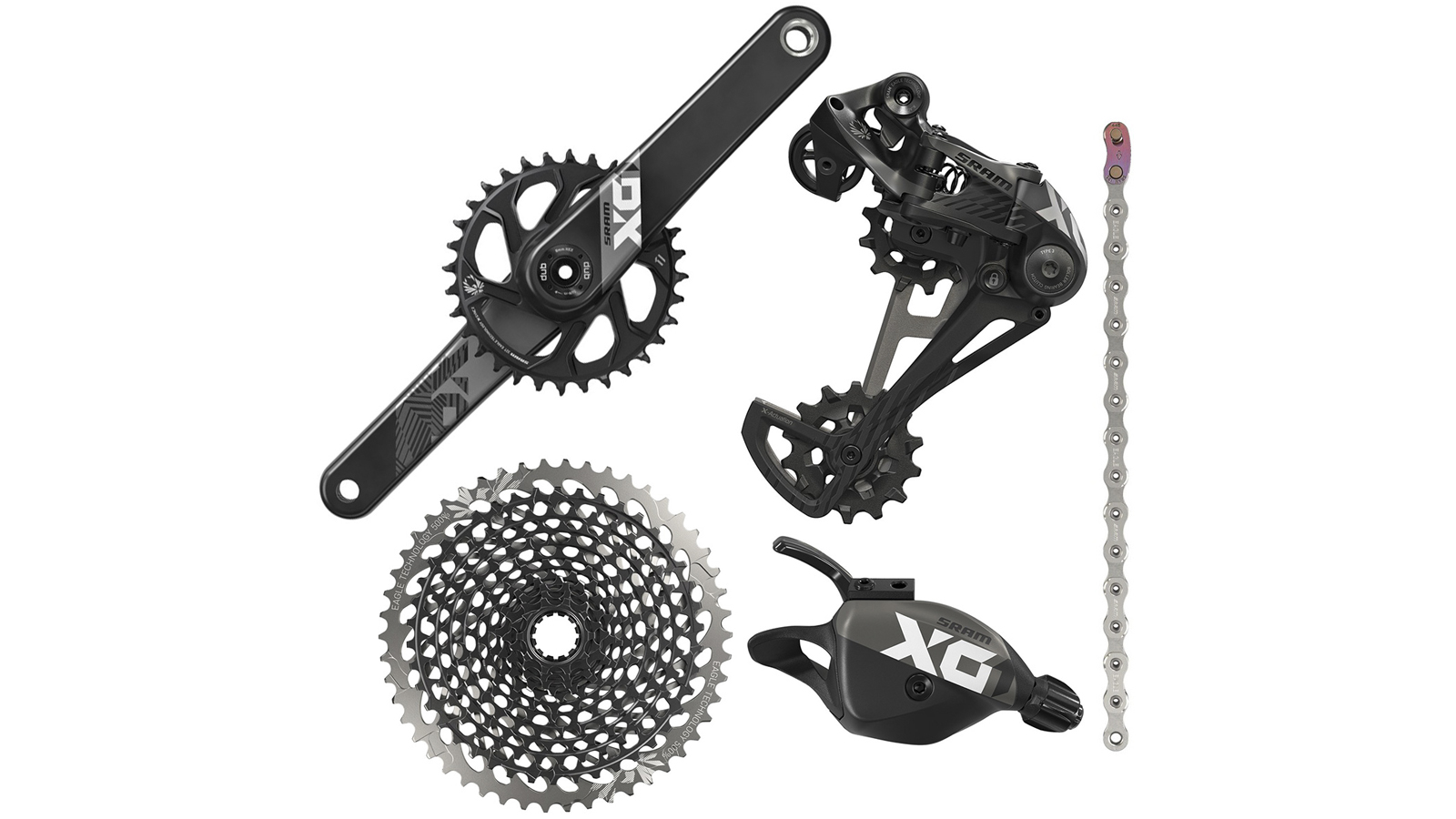
SRAM X01 Eagle
Specifications
Reasons to buy
Reasons to avoid
SRAM’s X01 Eagle delivers premium XX1 shifting performance over a 10-50 tooth cassette range with a little less gold bling and a little more toughness at a slighter cheaper price. The start and finish position of the shifter is tuneable and there are two mount points on the clamp. It gets a forged alloy trigger for strength too. Like all Eagle accurate set up is crucial but the ZeroLoss action is very quick and positive, so there’s no doubt when you’ve shifted.
A bearing rather than bushing for the lever means it feels fractionally lighter and more accurate than cheaper SRAM setups too. Harder gear shifts are singular only but you can sweep through several easier gears in one swing, or there’s a single click version for E-bikes. The rear mech uses a titanium spring and alloy ‘B bolt’ like XX1 but a forged alloy jockey wheel cage rather than a semi carbon one so it’s more repairable if it gets knocked into the spokes.
The hollow pin Hard Chrome chain is essentially the same too. The XG1295 X-Dome cassette is black and silver rather than gold like the XG1299 but uses the same one-piece machined steel section to reduce weight by 88g compared to GX and it’s 10g lighter than XTR. The 42-50 tooth jump is more obvious than Shimano though and there are no other ratio options.
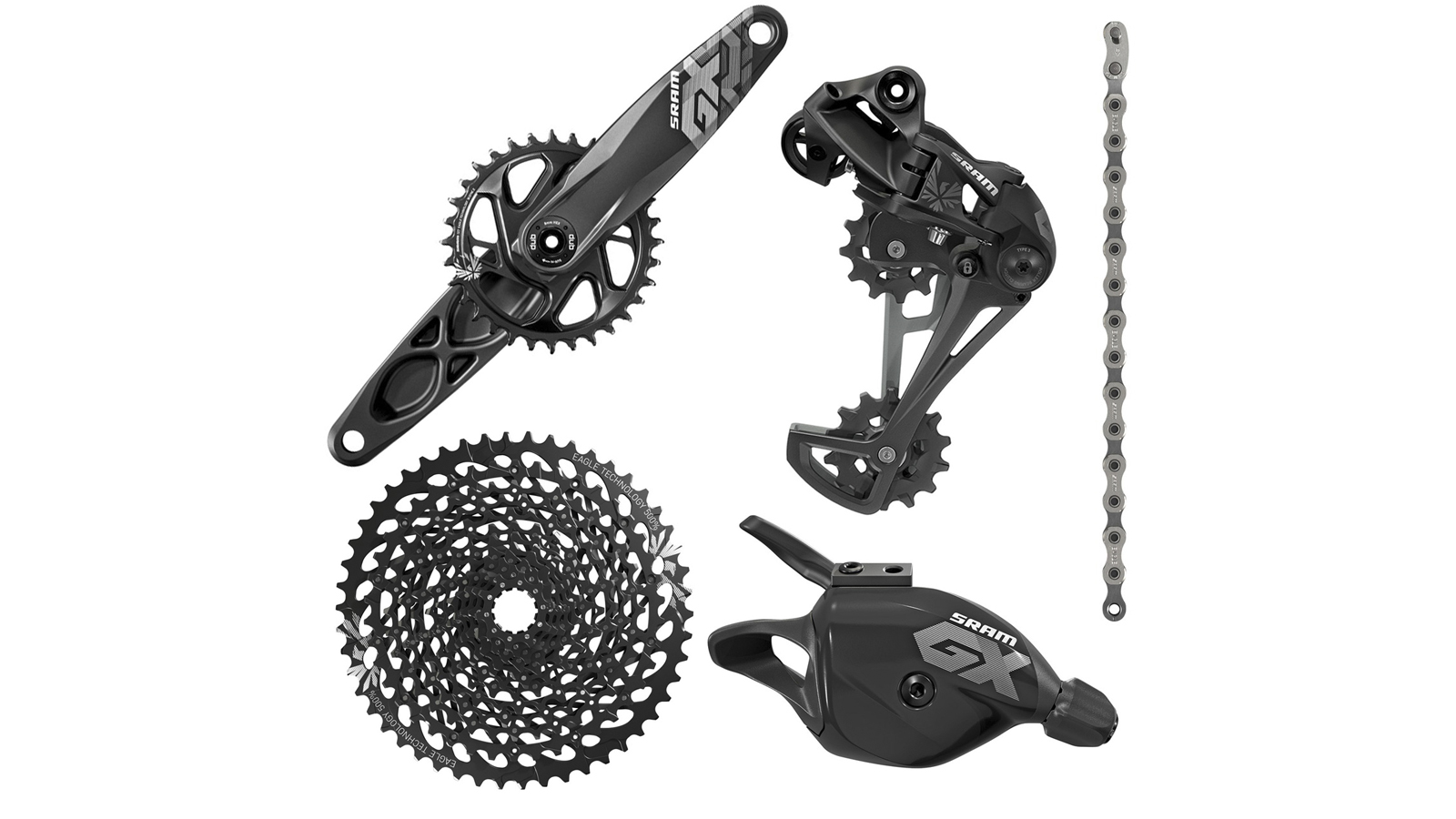
SRAM GX Eagle
Specifications
Reasons to buy
Reasons to avoid
GX uses slightly simpler construction techniques and cheaper materials than X01 and loses trigger angle adjustment, but shifting performance is indistinguishable. The biggest difference between GX and X01 is the XG1275 cassette which uses individually stamped steel cogs held together with stainless steel pins rather than a single piece X-Dome centrepiece.
That makes it 88g heavier but tooth shaping and therefore shifting is essentially identical and it still uses an XD driver to get the full 10-50 tooth range. The solid pin chain is heavier too but still gets the same ‘FlowLink’ profiling for quieter, longer-lasting operation. The rear mech gets a steel spring, steel B bolt, die-cast jockey cage and a plain finish. The actual jockey wheels and roller bearing clutch are the same though. Without an adjuster clamp on the main trigger, the shifter pod is actually 4g lighter and the lever is still forged alloy for strength.
This all adds up to a 118g weight gain over X01 and 4g over Shimano XT, but it’s 207g lighter than NX and well priced too. You’d have to be fastidious to notice that it has a bushing rather than a bearing for the push lever, so if you’re not a weight watcher this is definitely SRAM’s most cost-effective performance group.

SRAM NX Eagle
Specifications
Reasons to buy
Reasons to avoid
An entire NX groupset (including crank) costs less than an XX1 cassette but if you’re not concerned with weight, it’s won a lot of fans by still delivering most of the advantages of Eagle shifting in a totally bombproof format. How does it compare to new SRAM SX and Shimano SLX though?
The big difference between NX and more expensive SRAM groups is the PG (rather than XG) 1230 cassette. This uses a traditional splined freehub with a separate lock ring so it fits on cheaper wheels fine. The small cog is an 11, not a 10 giving a 455% gear range rather than 500% but we’ve rarely found that an issue on the trail. The all-steel cassette is also super tough (it used to be the only Eagle block SRAM rated for E-bike use). It is a proper anchor in weight terms at 614g - 166g heavier than GX which you can notice as extra unsprung weight if you’re really tuned into your suspension. The shifter pod is also fixed onto its own clamp rather than being compatible with shifter and brake mating ‘Matchmaker’ mounts. The supplied cables are decent though, so while shifting feel isn’t XO1/XX1 quality, it’s not obviously agricultural either.
Functionally very similar, the lower-priced SX undermines it on complete bikes but it’s not officially available aftermarket. Shimano’s SLX feels and looks slicker and weighs 114g less, however.

Box Two 11-Speed
Specifications
Reasons to buy
Reasons to avoid
Box has been trying to break into the MTB transmission market for a few years now and the Box Two is a more conventional evolution of their original Box One. The obvious operating difference is a Shimano style, push and pull two lever trigger shifter rather than the single lever push forward or click inward actuation of the One. Downshifts are single like SRAM but you can sweep up to three upshifts. The shifter isn’t Matchmaker or I-Spec compatible but the action is positive and can be tuned from relatively light to seriously stiff by adjusting the clutch resistance on the rear mech.
It stays that way right across the 11-46 tooth cassette option but it does need more effort to shift onto the biggest cog of the 50 tooth cassette compared to SRAM and Shimano though. The multi piece (two blocks on alloy carriers then five separate steel cogs) 11-speed cassette is also 22g heavier than Shimano SLX but lighter than NX which uses the same HG standard free hub.
The rear mech uses a ‘Pivot Tech’ spring loaded cable arm to helps shrug off impacts and as mentioned previously you can remove the clutch cover and change tension with a T25 key. Box also supply their own chain with a logo on every link but any other 11-speed chains will work fine.
Interestingly rather than chase the 12-speed market Box have just released a 9-speed ‘Prime 9’ group using a SRAM-style machined steel cassette construction to match the X01 block on weight.
A thicker plated 9-speed chain is used for durability and strength too, but bigger gaps between gears are obvious, particularly in the mid range.
How to buy the best mountain bike groupset
1. Price
Why trust BikePerfect
In terms of price, the first good news is that it’s a great time to buy. SRAM’s groupsets have all been 12-speed for a while, but the new SX group drops their Eagle 10-50 tooth cassette tech to the lowest price ever. Shimano surprised everyone by releasing 12-speed SLX at the same time as XT and with so little performance difference between them we know which we’d pick. That does leave 11-speed Shimano Deore looking a bit last-generation, but in terms of workhorse performance, it’s still an awesome option if you don’t need a super wide set of gears and never count the clicks on your shifters.
2. Cable, electric or hydraulic?
This is only a choice you need to worry about if money is no object. Connecting shifter to mech with an inner cable sliding through an outer cable housing is the traditional, failsafe, easy-to-service choice. It can be a pain to thread through frames when you’re building though and if cables get dirty or corrode, shifting speed and accuracy will degrade.
SRAM’s new AXS system has wireless communication and external batteries a no brainer in terms of easy fitting. It’s also fully customisable and syncs with RockShox’s wireless Reverb AXS dropper too. The fact that 12-speed versions of Shimano’s wired Di2 electric versions of XTR and XT haven’t been announced yet leaves it basically unopposed too. It’s a very expensive, hi-tech set of kit to have bolted to your bike if you’re clumsy though.
Rotor’s hydraulic system offers impressively direct shifting, their systems have proved reliable so far and there’s no reliance on battery life or cable longevity. It doesn’t dodge internal control routing problems, though, and adds it’s own servicing complications.
3. Shifters
While the function of most shifters from each brand are identical, the more you pay, the better quality they are. Better bearings and cables will mean your shifters will feel slicker and they’re likely to last longer. That means better shifters are often the smartest place to invest extra cash in terms of overall performance.
SRAM’s top shifters add more adjustability in terms of trigger positioning. SRAM only offer push/push shifting on their triggers while Shimano has a dual front and rear trigger for more shifting options. You can still get SRAM GripShift twist shifters if you want though.
4. Gears
All the groupsets here run 12-speed cassettes. SRAM XX1 to GX groups all use 10-50 tooth cassettes (NX and SX use 11-50T) but Shimano literally went one better by going 10-51 tooth as standard. The 6 tooth (45-51) bottom gear jump feels much smoother than SRAM’s 8 tooth (42-50) jump too, but leaves slightly bigger gaps lower down. If you don’t need a bailout gear Shimano also offer 10-45.
5. Freehubs
Fitting 10-tooth small cogs has meant new freehub standards to cope. SRAM developed XD which is pretty much universally available as an option (apart from Shimano wheels). Shimano wasn't initially as open with their new MicroDrive licensing, but a recent change in stance should open up compatibility options imminently. Major brands are starting to release compatible versions already.
6. Alternatives
Rotor has just announced an MTB version of their hydraulically actuated road groupset. We’ve not had a chance to use it yet but it comes with an optional super light 13-speed 10-52 tooth cassette and promises almost maintenance-free operation once you’ve set it up. Pricing and overall weights are comparable with XX1 AXS and XTR though so it’s definitely a premium performance option.

Guy Kesteven has been working on Bike Perfect since its launch in 2019. He started writing and testing for bike mags in 1996. Since then he’s written several million words about several thousand test bikes and a ridiculous amount of riding gear. He’s also penned a handful of bike-related books and he reviews MTBs over on YouTube.
Current rides: Cervelo ZFS-5, Specialized Chisel, custom Nicolai enduro tandem, Landescape/Swallow custom gravel tandem
Height: 180cm
Weight: 69kg
